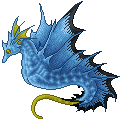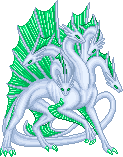Species name: Northern Aquatic
Origin: The -exact- origins of this particular mutation is still under question. Whether it was the result of adapations that certain aquatics had developed after they had fled to colder climes - or if it were simply the result of the northern Samanayr mutating as the harsh environments of the north forced them into the water in search of sustenence - is unknown. Isolated from most other Samanayr due to the general unlivable nature of their habitat, the Northern Aquatic have bred alone for so many years that they themselves no longer remember. Although, as a general rule, they feel slightly more in tune with their Northern brethren than any warm-watered aquatics.
Special traits: While Northern Aquatics are capable of bearing many of the typical Northern mutations - it is very, very rare to encounter one that does not bear a pudgy & flippered trait - usually four flippers in total, although the number (and size) can vary. Actual more fish-like fins are extremely rare, and the larger winged traits little more than legend.
Also, like other Aquatics - they do actually breathe air, not water, and simply can hold their breath for a very, very long time. They do come onto land occasionally, but prefer to live the majority of their time out at sea.
Another couple of new traits has been observed within their ranks howewver - tusks, both small and large, are primarily observed on some. Small ears, and earless (only ear holes). As well as fanned, flipper-like tail, furred flippers and indeed, velveted fur - a denser, and often shorter, version of their Northern cousin's coat.
Special markings/colors: Generally duller, muted tones. Usually whites, blues, greys and the occasional purple - like the sea.
Abilities: n/a
How to breed: A true Northern Aquatic is produced only when bred to another Northern Aquatic, or when bred to a fullblooded Northern and possessing the pudgy & flipper (four) mutations.
Breeding restrictions: n/a
Anything else? (optional)
-
Pictoral Examples:
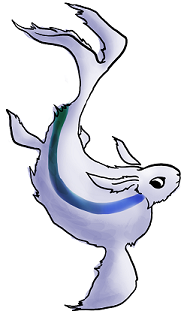
1. Full blooded Aquatic - pudgy, velveted fur, furred flippers & flipper-tail. Grey-blue in color.
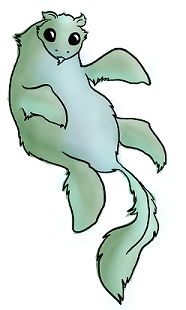
2. Full blooded Aquatic - pudgy, velveted fur, furred flippers & small ears & greenish blue in color.
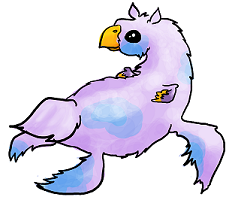
3. Full blooded Aquatic - pudgy, velveted fur, furred flippers, small ears, beak & vestigal wings - lavender & blue in color.
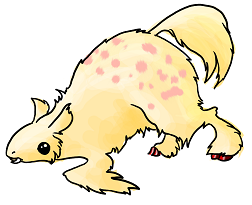
4. Halfbreed Northern/Northern aquatic. Velveted fur. Small tusks. Furred flipper & hooves. Brighter colors. As as can you can see, in the case of crosses, those that do not inherit all of ONE of their parents limbs are generally viewed as ungainly and literally a aquatic out of water. In the harsher climes, often will not survive long. Because of this, also not generally favored within the more typical songs or company.
-
An OPTIONAL (if that is allowed) potential song variation of the Northern Aquatic:
A fully northern aquatic song structure can vary slightly from the typical Samanayar song. Because of the extremely harsh nature of their environment, larger groups of Northern Aquatics have historically held the greater chance for survival. Therefore, a tradition of a second-stallion, and the "harmonic" song has emerged. This sub-song almost functions like a fully independent song - but is generally smaller. (The primary or "melodic" song generally composed of the normal 1/4 ratio of stallion/mare - although they can, occasionally be as large as 1:6 if there has been a death of one of the stallions- and the sub song comprised of a 1/2-3 ratio.)
This pair of songs are generally very friendly towards eachother - traveling together, and caring for eachother and the other's young. Influence within the song is fairly typical - with the first-stallion being the head, and the mares (outside of the lead mare of the primary song) considered to be on equal footing. The second-stallion and the primary lead mare's influence are generally about equal - although their EXACT authority of one over the other varies from song to song.
The first stallion is usually a stronger male - while the second stallion is usually a younger, more inexperienced one. Should anything catastrophic occur to the first stallion, usually the second stallion will step up to take the primary stallions place. Similarly, if the second stallion meets with an unfortunate end, the first stallion will generally absorbe the harmonic song's mares into his own song.
Such power shifts, however, are not without their costs - as usually a couple of mares (frequently at LEAST the lead mare of the newly-absorbed song) will leave the song to pursue other possibilities - their leaving resulting in diminishing the combined songs to the a more "typical" size. It HAS been known for the group to be so close-knit that they stay together as one big, single song - however such a combination has then NEVER been known to allow/seek another harmonic song as a result.
Frequently harmonic songs are start as offspring that are considered too close to leave the group. A male offspring from the primary song will grow up and decide to become a second-stallion, and collect unrelated mares to form a harmonic song - or a female offspring will grow up and join/convince an unrelated stallion in an harmonic song for the group. These particular individuals, however, are generally the first to leave should the above-mentioned power shift occur - simply because inbreeding is looked on with distaste, and while they may stay with the song for a little while until they can find a new song to join with ... they are members in name only, and would never consider breeding with their related family.
Also, occasionally, harmonic songs will break off from the primary to become their own, independent song - with the seperated songs now able to seek their own new harmonic songs to pair with. These songs are also generally the first to trade family unrelated members between eachother should a harmonic song be started within the other member's ranks.







































































